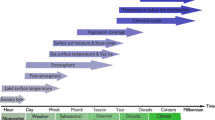Abstract
In this contribution, some of the issues related to the workings of climate models are discussed. The hierarchy of available models is mentioned, and examples are given of both the simplest process models and of state-of-the-art global climate models. The concepts of climate scenarios and climate predictability are discussed, and the methods for validating climate models are mentioned. Some of the many open questions in climate modelling are explored, focussing in particular on the issue of scale interaction: on the one hand, the need for downscaling the large-scale climate information for impact studies, using regional climate models and statistical/stochastic downscaling procedures; on the other hand, the need for upscaling the small-scale dynamics associated with surface processes to quantify their effects on regional and global climate. The general theme of the parameterization of unresolved, sub-grid scale processes such as turbulent convection is also mentioned. The specific example of climate–biosphere interaction is considered in some detail, with specific attention to the issue of climate–vegetation interaction in arid and semi-arid regions and the role of vegetation in determining albedo and moisture fluxes. The need for a deeper understanding of the fundamentals of climate dynamics is finally advocated.



Similar content being viewed by others
References
Maraun D et al (2010) Precipitation downscaling under climate change: recent developments to bridge the gap between dynamical models and the end user. Rev Geophys 48, RG3003. doi:10.1029/2009RG000314
Baudena M, D’Andrea F, Provenzale A (2008) A model for soil-vegetation-atmosphere interactions in water-limited ecosystems. Water Resour Res 44:1–9
Brovkin V, Claussen M, Petoukhov V, Ganopolski A (1998) On the stability of the atmosphere-vegetation system in the Sahara/Sahel region. J. Geophys. Res. 103: 31613–31624
Charney J (1975) Dynamics of deserts and droughts in the Sahel. Q J Roy Meteor Soc 101:193–202
Claussen M (1998) On multiple solutions of the atmosphere–vegetation system in present-day climate. Glob Change Biol 4:549–559
Cresto Aleina F, Baudena M, D’Andrea F, Provenzale A (2013) Multiple equilibria on planet Dune: climate-vegetation dynamics on a sandy planet. Tellus B. doi:10.3402/tellusb.v65i0.17662
D’Andrea F, Provenzale A, Vautard R, De Noblet-Decoudré N (2006) Hot and cool summers: multiple equilibria of the continental water cycle. Geophys Res Lett. doi:10.1029/2006GL027972
Fyfe JC, Gillett NP, Zwiers FW (2013) Overestimated global warming over the past 20 years. Nat Climate Change 3:767–769
Gilad E, von Hardenberg J, Provenzale A, Shachak M, Meron E (2007) A mathematical model of plants as ecosystem engineers. J Theoretical Biol 244:680–691
Giorgi F (1990) Simulation of regional climate using a limited area model nested in a general-circulation model. J Climate 3:941–963
Jasechko S et al (2013) Terrestrial water fluxes dominated by transpiration. Nature 496:347–350
Jones CG, Lawton JH, Shachak M (1997) Positive and negative effects of organisms as ecosystem engineers. Ecology 78:1946–1957
Kalnay E (2003) Atmospheric modeling, data assimilation and predictability. Cambridge University Press, Cambridge
Knutti R (2008) Should we believe model predictions of future climate change? Phil Trans R Soc A 366:4647–4664
Lovelock JE (1979) Gaia: A new look at life on Earth. Oxford University Press, Oxford
McGuffie K, Henderson-Sellers A (2005) A climate modelling primer. Wiley, Chichester
Moss RH et al (2010) The next generation of scenarios for climate change research and assessment. Nature 463:747–756
North GR, Cahalan RF, Coakley JA Jr (1981) Energy balance climate models. Rev Geophys Space Phys 19:91–121
Odling-Smee FJ, Laland KN, Feldman MW (2003) Niche construction: the neglected process in evolution. Princeton University Press, Princeton
Palmer TN, Doblas-Reyes FJ, Weisheimer A, Rodwell MJ (2008) Toward seamless prediction: calibration of climate change projections using seasonal forecasts. Bull Am Meteor Soc 89:459–470
Parmesan C (2006) Ecological and evolutionary responses to recent climate change. Annu Rev Ecol Evol Syst 37:637–669
Pasini A (2005) From observations to simulations. World Scientific, Singapore
Rebora N, Ferraris L, von Hardenberg J, Provenzale A (2006) RainFARM: rainfall downscaling by a filtered autoregressive model. J Hydrometeorol 7:724–738
Rietkerk M et al (2011) Local ecosystem feedbacks and critical transitions in the climate. Ecol Complex 8:223–228
Stevens B, Bony S (2013) What are climate models missing? Science 340:1053–1054
Tyler DR, Catling DC (2012) An analytic radiative-convective model for planetary atmospheres. Astrophys J. doi:10.1088/0004-637X/757/1/104
Vallis GK (2006) Atmospheric and oceanic fluid dynamics. Cambridge University Press, Cambridge
Vernadsky V (1926) Biosfera (in Russian). Nauch, Leningrad. English version (1997) The Biosphere, Springer Copernicus, New York
Ward P (2009) The Medea hypothesis. Princeton Univesity Press, Princeton
Acknowledgments
I am grateful to Jost von Hardenberg, Elisa Palazzi, Claudia Pasquero, Antonio Parodi, Alexandre Pieri, Silvia Terzago, Luca Filippi, Paolo Davini, Donatella D’Onofrio and Marco Turco for many interesting discussions. Figure 2 refers to the Master Thesis of Luca Filippi and it displays EC-Earth model simulations performed by Jost von Hardenberg. Many thanks to Antonello Pasini and an anonymous reviewer for useful comments. This work was supported by the Project of Interest NextData of the Italian Ministry for Education, University and Research (MIUR).
Author information
Authors and Affiliations
Corresponding author
Rights and permissions
About this article
Cite this article
Provenzale, A. Climate models. Rend. Fis. Acc. Lincei 25, 49–58 (2014). https://doi.org/10.1007/s12210-013-0268-7
Received:
Accepted:
Published:
Issue Date:
DOI: https://doi.org/10.1007/s12210-013-0268-7




